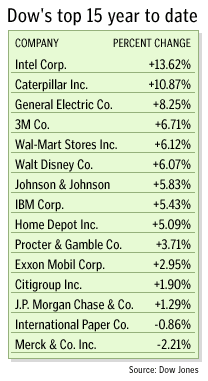NEW YORK (CNN/Money) -
It didn't pay to buy stocks that pay dividends.
That's what investors learned during the first three months of 2003, when the total return of 2,273 dividend-paying stocks was a negative 1.4 percent, according to data from Baseline.
During the same time, 3,700 non-dividend-paying stocks returned a negative 1 percent this year, reversing a trend of under-performance as old as the current bear market.
It wasn't supposed to be this way. President Bush began the year with a plan to eliminate taxes on dividends in a move expected to help stocks of companies that pass profits to investors.

A third year of steep stock market losses in technology and telecom stocks, which generally don't pay dividends, was supposed to prove the supremacy of income-generating securities.
And accounting scandals at Enron, WorldCom and elsewhere taught this: A company can lie about profits, but it can't fake dividends.
Still, the dividend-paying stocks in the Wilshire 5000 index are down 1.62 percent in 2003, according to Wilshire Associates, while non-dividend payers are 1.09 percent higher.
The best-performing sector in the Standard & Poor's 500 index this year has been technology, which rose 4.6 percent. This year's best-performing Dow Jones industrial average stock is Intel, which rose 13.6 percent and pays a tiny quarterly dividend of 2 cents a share.
And 2003's top major index is the Nasdaq composite, which is 2.5 percent higher on the year. The Dow industrials are down 2.3 percent.
"I think it's the pendulum swinging back toward growth from defensive stocks," said Chuck Carlson, CEO of Horizon Investment Services.
The pendulum has a long way to swing. Since the Standard & Poor's 500 index peaked on March 24, 2000, value stocks in that index are down 32.9 percent, according to S&P. But the growth stocks have fallen 52.6 percent during a three-year stretch when the overall index is off 43.4 percent.
'Taking profits'
Sam Stovall, chief investment strategist at Standard & Poor's, calls this year's move into non-dividend stocks a natural reaction to the long out-performance of value.

"It's possible it got to the point where valuations [of value stocks] were stretched," Stovall said. "I think investors were just taking profits."
The market has seen this before. A series of technology-led rallies over the last three years were nothing but head fakes.
Over the last three years, only one S&P industry sector is higher: Consumer staples. They're up 16.4 percent, thanks to stocks like Procter & Gamble (PG: Research, Estimates). But telecommunications stocks are down 70.7 percent and technology is off 76.7 percent since the market peaked.
The recent move into growth, S&P's Stovall said, fits the historical pattern of technology stocks advancing on hopes for an improving economy. At the same time, technology shares may have lost most of their risk because their steep losses.
"The feeling is the worst is probably over for tech," Stovall said.
Who kept the dogs in?
Some investors start each year buying the 10 highest-yielding Dow stocks. A stock's yield is determined by dividing annual dividend by the share price. But so far, this Dogs of the Dow strategy, which is a bet that out-of-favor quality stocks will outperform, has failed.
The Dow's top 10 yielders three months ago were Caterpillar, DuPont, Eastman Kodak, General Electric, General Motors, Honeywell, J.P. Morgan Chase, Altria, SBC Communications and AT&T.
Only three of them -- J.P. Morgan, General Electric and Caterpillar -- are higher on the year. And four -- Kodak, Altria, SBC Communications and AT&T -- are suffering double-digit percentage losses.
Looking ahead, Horizon Investment's Carlson says the growth/value dynamic is likely to keep favoring growth. That's particularly the case if war in Iraq proves fast and successful.
Betting on this scenario, Carlson said he has bought Microsoft (MSFT: Research, Estimates), Pfizer (PFE: Research, Estimates), Gannett (GCI: Research, Estimates) and Scotts (SMG: Research, Estimates) recently
"I happen to believe that the pendulum is returning to the growth side," Carlson said.
This year, he's not alone.

|

